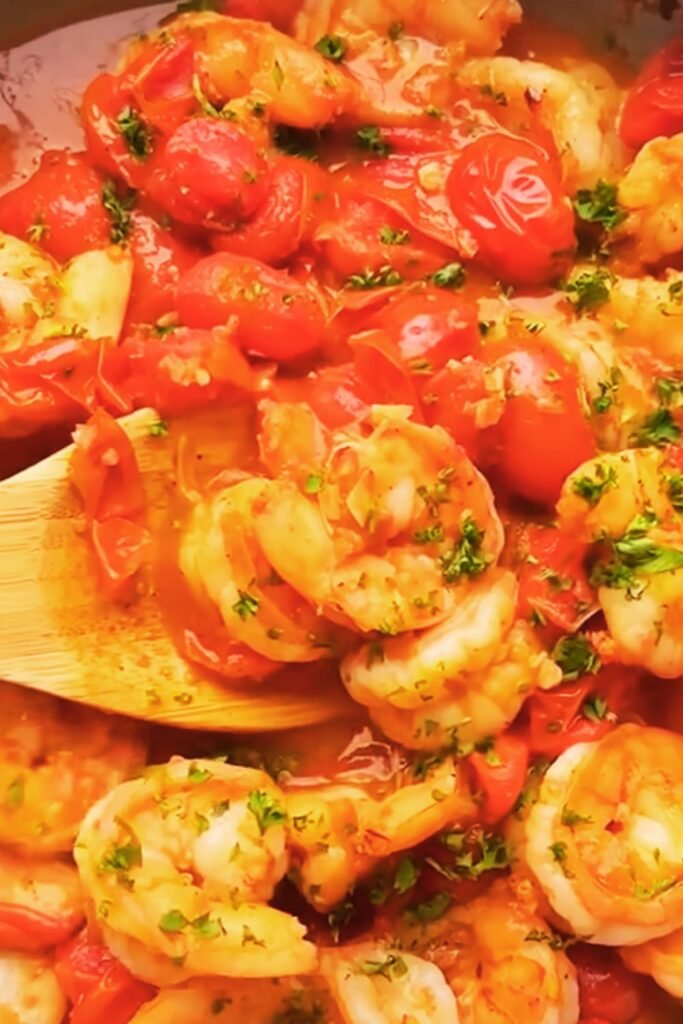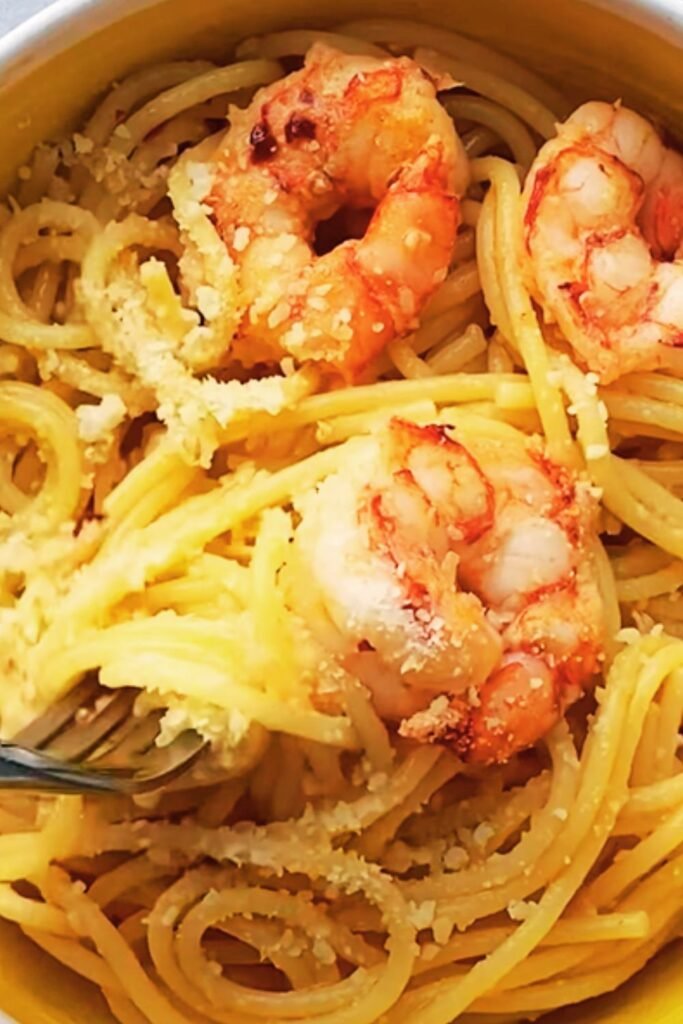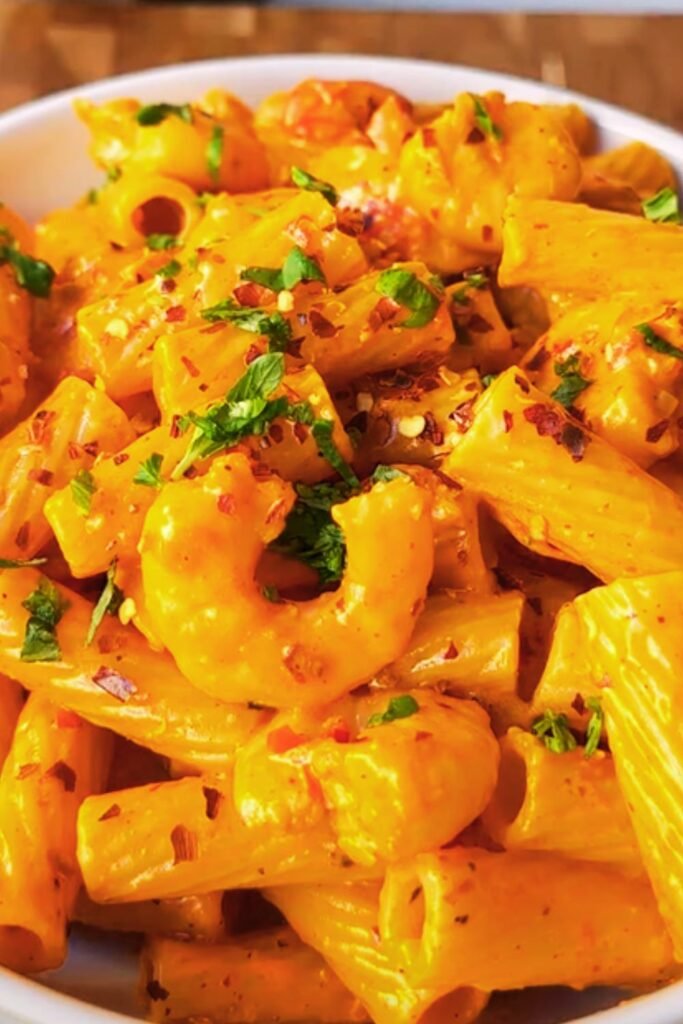There’s something magical about the combination of spicy Calabrian chilies, aromatic garlic, and succulent shrimp that transforms a simple pasta dish into something extraordinary. I discovered this recipe during a summer trip to southern Italy, and it’s become my go-to dish when I want to impress dinner guests without spending hours in the kitchen. The secret lies in the balance between the heat of the chilies and the natural sweetness of the shrimp – a combination that dances on your taste buds with every bite.
What Makes This Dish Special
This pasta isn’t just another spicy shrimp dish – it’s a carefully crafted balance of flavors that showcases the beautiful simplicity of Italian coastal cooking. The Calabrian chilies bring a distinct fruity heat that commercial hot sauces simply can’t replicate. When paired with generous amounts of garlic, quality olive oil, and fresh seafood, you get a dish that feels both rustic and sophisticated.
I love making this on weeknights when I need something impressive that comes together in under 30 minutes. The ingredients list is relatively short, but each component plays an essential role in creating the final flavor profile.
Ingredients
For the Pasta and Shrimp
- 1 pound (454g) linguine or spaghetti
- 1½ pounds (680g) large shrimp, peeled and deveined (16-20 count)
- 8 cloves garlic, thinly sliced
- 2-3 tablespoons Calabrian chili paste (adjust according to heat preference)
- ⅓ cup high-quality extra virgin olive oil
- 1 teaspoon sea salt, plus more for pasta water
- ½ teaspoon freshly ground black pepper
- ¼ cup fresh parsley, finely chopped
- Zest of one lemon
- 2 tablespoons fresh lemon juice
For Garnish
- Additional chopped parsley
- Grated Pecorino Romano or Parmesan cheese (optional)
- Extra Calabrian chili flakes (for those who enjoy extra heat)
- Lemon wedges
Essential Equipment
Having the right tools makes preparing this dish much more efficient:
- Large pot for boiling pasta
- Colander for draining
- Large skillet or sauté pan (12-inch is ideal)
- Sharp knife for slicing garlic and herbs
- Microplane for lemon zest
- Wooden spoon or tongs for tossing pasta
Preparation Steps
Preparing the Shrimp
The key to perfect shrimp in this dish is proper preparation and careful cooking to avoid the rubbery texture that comes from overcooking.
- If using frozen shrimp, thaw completely by placing in a colander under cold running water for 5-7 minutes.
- Pat the shrimp dry with paper towels – this is crucial for proper searing.
- Season shrimp with ½ teaspoon salt and ¼ teaspoon black pepper.
- Check for any remaining shells or veins and remove them.
Making the Calabrian Chili Sauce
This is where the magic happens. The process of infusing the oil with garlic and chili creates the foundation of flavors for the entire dish.
- In a large skillet, heat olive oil over medium-low heat.
- Add sliced garlic and cook gently for 2-3 minutes until fragrant but not browned – garlic becomes bitter when browned.
- Add Calabrian chili paste and stir to incorporate into the oil, creating a vibrant red-orange sauce.
- Simmer on low heat for 1-2 minutes to allow the flavors to meld.

Cooking the Pasta Perfectly
Properly cooked pasta is essential for this dish. You want it slightly firmer than al dente since it will continue cooking briefly in the sauce.
- Bring a large pot of water to a rolling boil.
- Add 1-2 tablespoons of salt (the water should taste like seawater).
- Add pasta and cook for 1-2 minutes less than package directions indicate.
- Before draining, reserve 1 cup of the starchy pasta water.
- Drain pasta but do not rinse – the starch helps the sauce adhere.
Bringing It All Together
The final steps require quick timing to ensure everything comes together perfectly without overcooking the delicate shrimp.
- Increase the heat under the chili-garlic oil to medium-high.
- Add the seasoned shrimp to the skillet in a single layer.
- Cook for about 2 minutes on the first side until pink and starting to curl.
- Flip shrimp and cook for another 1-2 minutes until just cooked through.
- Add the drained pasta directly to the skillet.
- Pour in ¼ cup of reserved pasta water and toss everything together.
- Add lemon zest, lemon juice, and most of the chopped parsley (reserve some for garnish).
- Continue tossing until the sauce coats each strand of pasta evenly, adding more pasta water if needed to achieve a silky consistency.
- Taste and adjust seasoning with additional salt and pepper if needed.
Nutritional Information
For those watching their nutrition intake, here’s a breakdown of what you can expect per serving (based on 4 servings):
| Nutrient | Amount per Serving |
|---|---|
| Calories | 620 |
| Protein | 42g |
| Carbohydrates | 65g |
| Fat | 22g |
| Saturated Fat | 3g |
| Dietary Fiber | 3g |
| Sodium | 890mg |
| Vitamin C | 15% DV |
| Iron | 20% DV |
| Calcium | 12% DV |
Tips for Perfect Results
Over the years, I’ve discovered several tricks that elevate this dish from good to unforgettable:
- Use fresh shrimp when possible: The flavor difference is noticeable. If using frozen, ensure they’re completely thawed and dried before cooking.
- Don’t overcrowd the pan when cooking shrimp: Cook in batches if necessary. Overcrowding leads to steaming rather than searing.
- Adjust the chili level gradually: Calabrian chilies can vary in heat. Start with less and add more after tasting.
- Reserve more pasta water than you think you’ll need: It’s the secret to a silky sauce that perfectly coats the pasta.
- Undercook the pasta slightly: It will continue cooking when added to the hot sauce.
- Use a wide skillet: This allows for better evaporation and concentration of flavors.
Variations to Try
While the classic recipe is perfect as is, here are some variations I’ve experimented with over the years:
Seafood Medley Version
Add 8 oz of cleaned calamari rings and 12 mussels (cleaned and debearded) along with the shrimp for a more substantial seafood pasta.
Vegetable-Enhanced Option
Add 1 pint of halved cherry tomatoes and 2 cups of baby spinach. Add tomatoes when cooking the garlic and add spinach during the final toss.
Creamy Adaptation
For a richer version, add ¼ cup of heavy cream to the sauce just before adding the pasta.

The Origin of Calabrian Chilies
Calabrian chilies come from Calabria, the “toe” of Italy’s boot. This southern region is known for its spicy cuisine, which stands out in a country often associated with milder flavors. The chilies (also called peperoncino calabrese) have been cultivated there for centuries after being introduced from the Americas.
These particular chilies are typically:
- Small and conical in shape
- Bright red when fully ripened
- Moderately hot (about 25,000-40,000 Scoville units)
- Fruity and smoky in flavor profile
What makes them special for this dish is their complex flavor that goes beyond just heat – they add fruitiness, smokiness, and a depth that simple red pepper flakes can’t match.
Serving Suggestions
To create a complete meal experience around this pasta dish, I recommend:
Side Dishes
- A simple arugula salad with lemon vinaigrette
- Crusty Italian bread for sopping up extra sauce
- Roasted asparagus with a touch of lemon
Beverages
- Sparkling water with a slice of lemon
- Chilled iced tea with mint
- Italian soda with a splash of cream
Dessert Pairings
- Lemon sorbet for a refreshing palate cleanser
- Vanilla panna cotta with fresh berries
- Classic tiramisu for a traditional finish
Make-Ahead and Storage Tips
This dish is best enjoyed fresh, but there are ways to prepare components ahead of time:
Prep-Ahead Options
- Clean and season shrimp up to 8 hours ahead (refrigerate)
- Slice garlic and chop herbs up to 4 hours ahead
- Mix the Calabrian chili paste with half the olive oil to bloom flavors
Storage Guidelines
- Refrigerate leftovers in an airtight container for up to 2 days
- Reheat gently in a skillet with a splash of water
- Not recommended for freezing as the texture of both pasta and shrimp will suffer
Reviving Leftovers
When reheating, add:
- A drizzle of fresh olive oil
- A squeeze of lemon juice
- A sprinkle of fresh herbs

Sourcing Quality Ingredients
The simplicity of this dish means the quality of each ingredient matters significantly:
Finding Calabrian Chili Paste
- Italian specialty stores often carry authentic brands
- Some well-stocked supermarkets carry it in the international aisle
- Online retailers like Amazon, Eataly, or specialty food websites
Selecting Shrimp
Look for:
- Wild-caught when possible (better flavor and sustainable)
- Transparent flesh with no black spots
- No ammonia smell (indicates age)
- “Shell-on” options often have better flavor (remove before cooking)
Pasta Selection
While any long pasta works, I prefer:
- Bronze-die extruded pasta which has a rougher texture that holds sauce better
- Artisanal dried pasta made with high-protein semolina flour
- Linguine or spaghetti for this particular dish (fettuccine works well for the creamy variation)
Common Mistakes to Avoid
After making this dish dozens of times, I’ve identified these common pitfalls:
- Burning the garlic: This creates bitterness that ruins the dish. Keep heat moderate and stir frequently.
- Overcooking the shrimp: They continue cooking from residual heat, so remove from heat when just barely pink.
- Using too little pasta water: The starchy water is essential for creating a silky sauce that clings to the pasta.
- Under-salting the pasta water: Properly seasoned water is crucial for flavorful pasta.
- Adding cheese too early: If using cheese, add it at the very end after removing from heat to prevent clumping.
Health Benefits
Beyond being delicious, this dish offers several nutritional advantages:
- Shrimp provides high-quality lean protein and important minerals like selenium and iodine.
- Olive oil delivers heart-healthy monounsaturated fats and antioxidants.
- Garlic contains allicin, which has antimicrobial properties and may help lower blood pressure.
- Calabrian chilies are rich in capsaicin, which can boost metabolism and has anti-inflammatory properties.
- Lemon adds vitamin C and brightens flavors without extra calories.
Questions and Answers
Is this dish very spicy? The spice level is entirely customizable. Using 1 tablespoon of Calabrian chili paste creates a mild warmth, while 3 tablespoons delivers significant heat. Start with less and add more to taste.
Can I substitute the Calabrian chili paste? If you can’t find Calabrian chili paste, you can substitute with 1-2 teaspoons of red pepper flakes mixed with 1 tablespoon of tomato paste and a dash of smoked paprika. The flavor won’t be identical but will provide a similar profile.
Is this dish gluten-free? Not as written, but it can easily be made gluten-free by substituting your favorite gluten-free pasta. The rest of the ingredients are naturally gluten-free.
How crucial is the lemon component? Very important! The acidity from the lemon balances the richness of the olive oil and the heat from the chilies. If you don’t have lemon, try a splash of white wine vinegar instead.
Can I make this with chicken instead of shrimp? Absolutely. Use boneless, skinless chicken thighs cut into 1-inch pieces. They’ll need about 5-6 minutes of cooking time instead of the 3-4 minutes for shrimp.
How do I prevent the garlic from burning? Start with cold oil and sliced (not minced) garlic. Heat them together slowly, which allows the garlic flavor to infuse the oil without burning. Remove the pan from heat temporarily if the garlic is cooking too quickly.
What’s the best pasta shape for this sauce? Long pasta shapes like linguine, spaghetti, or bucatini work best because the sauce clings well to them. Avoid short shapes like penne or farfalle for this particular sauce.
Can I add vegetables to make it a complete meal? Absolutely! Cherry tomatoes, spinach, asparagus tips, or thinly sliced bell peppers all work well. Add firmer vegetables when cooking the garlic and more delicate ones just before adding the pasta.
Final Thoughts
This Garlicky Calabrian Chili Pasta with Shrimp embodies what I love most about Italian cooking – simplicity that highlights quality ingredients. It’s a dish that’s greater than the sum of its parts, creating a memorable meal experience that feels both comforting and exciting at the same time.
The balance of spicy, garlicky oil against the sweet backdrop of perfectly cooked shrimp creates something truly special. And while it may seem like a simple pasta dish, the careful layering of flavors and textures makes it restaurant-worthy without requiring professional culinary skills.
I hope you enjoy making this dish as much as I enjoy sharing it. It’s become my signature recipe for a reason – it never fails to impress while remaining accessible for weeknight cooking. Once you master the basic technique, you’ll find yourself returning to it again and again, perhaps creating your own variations along the way.